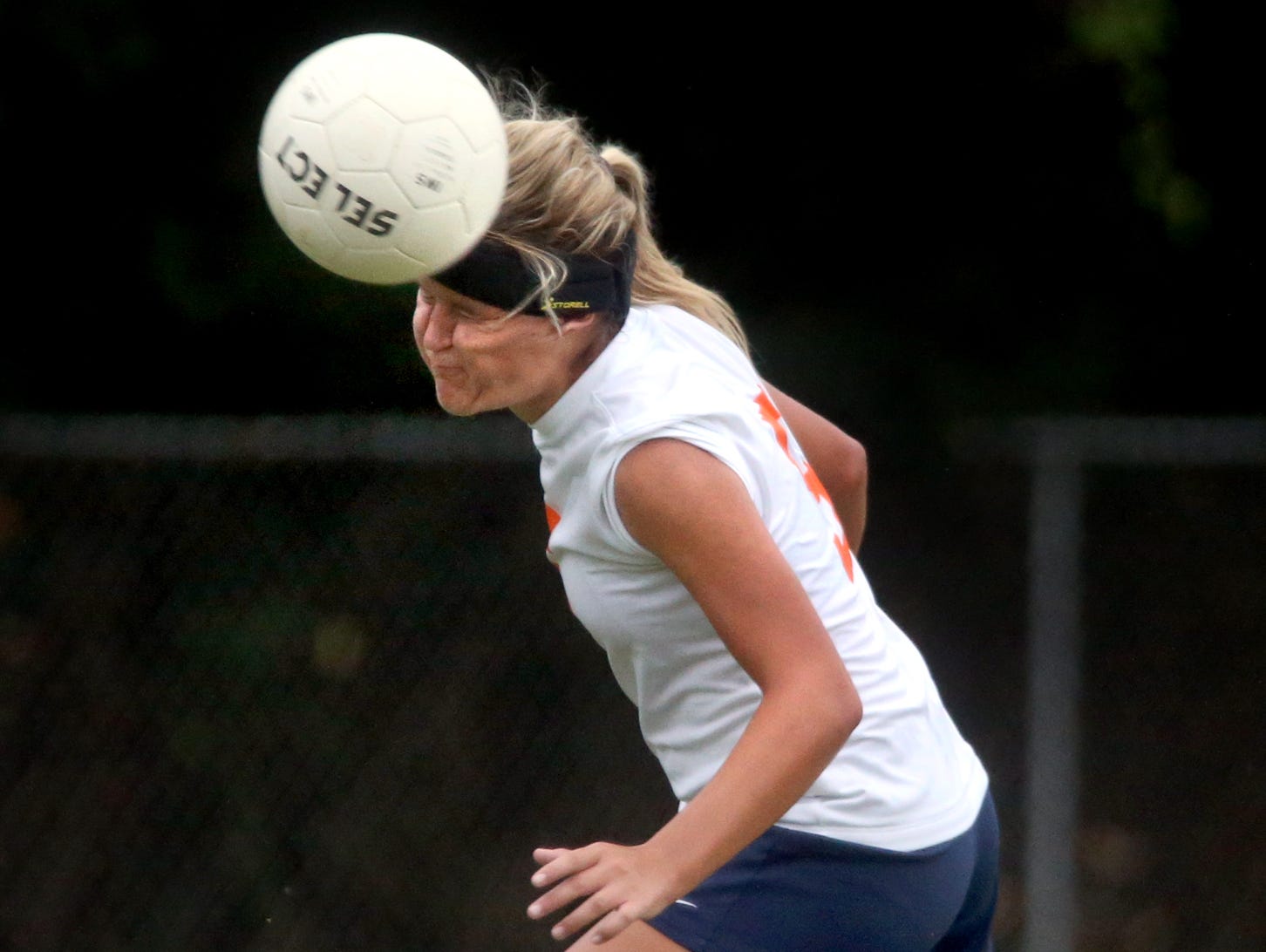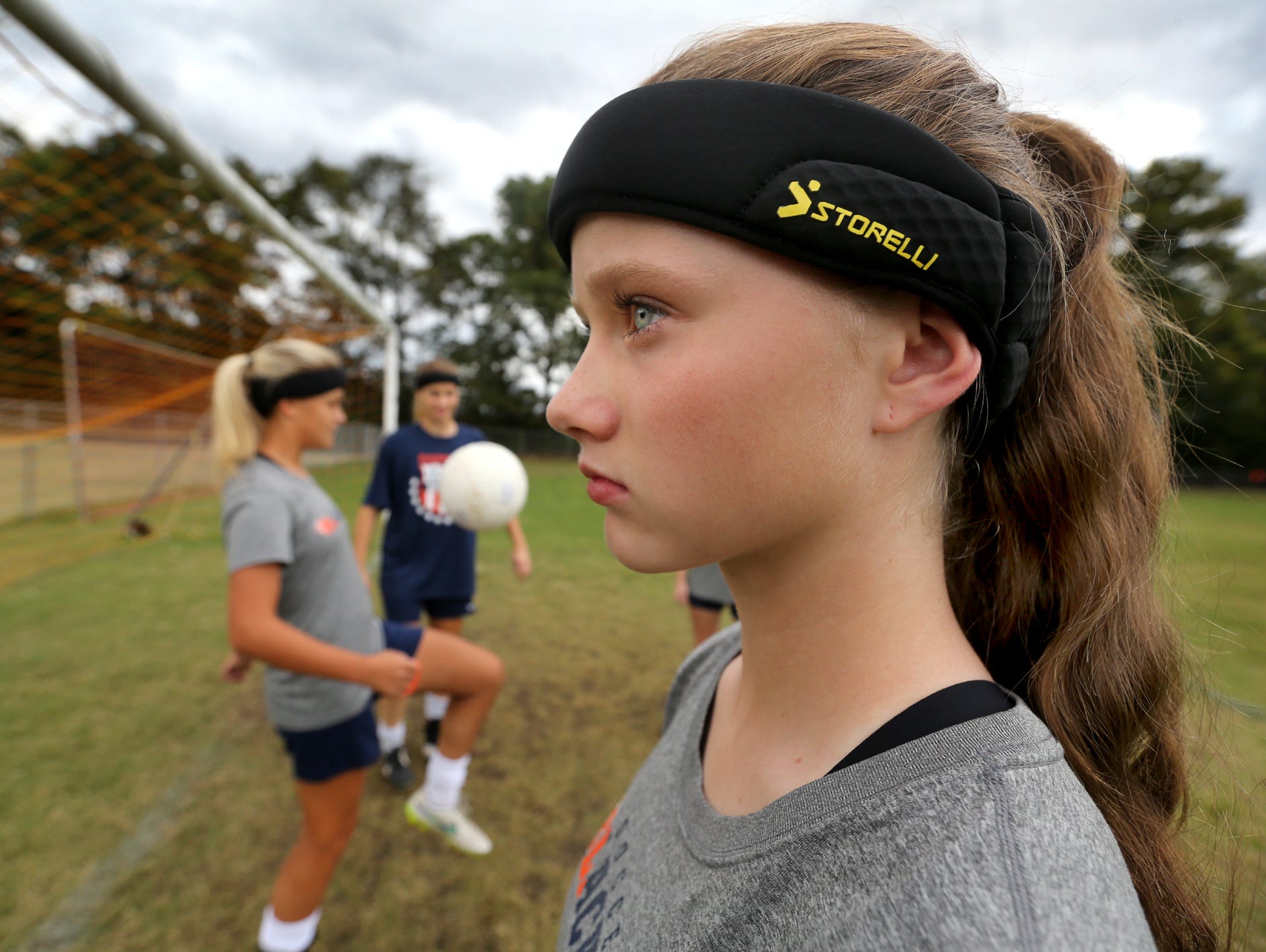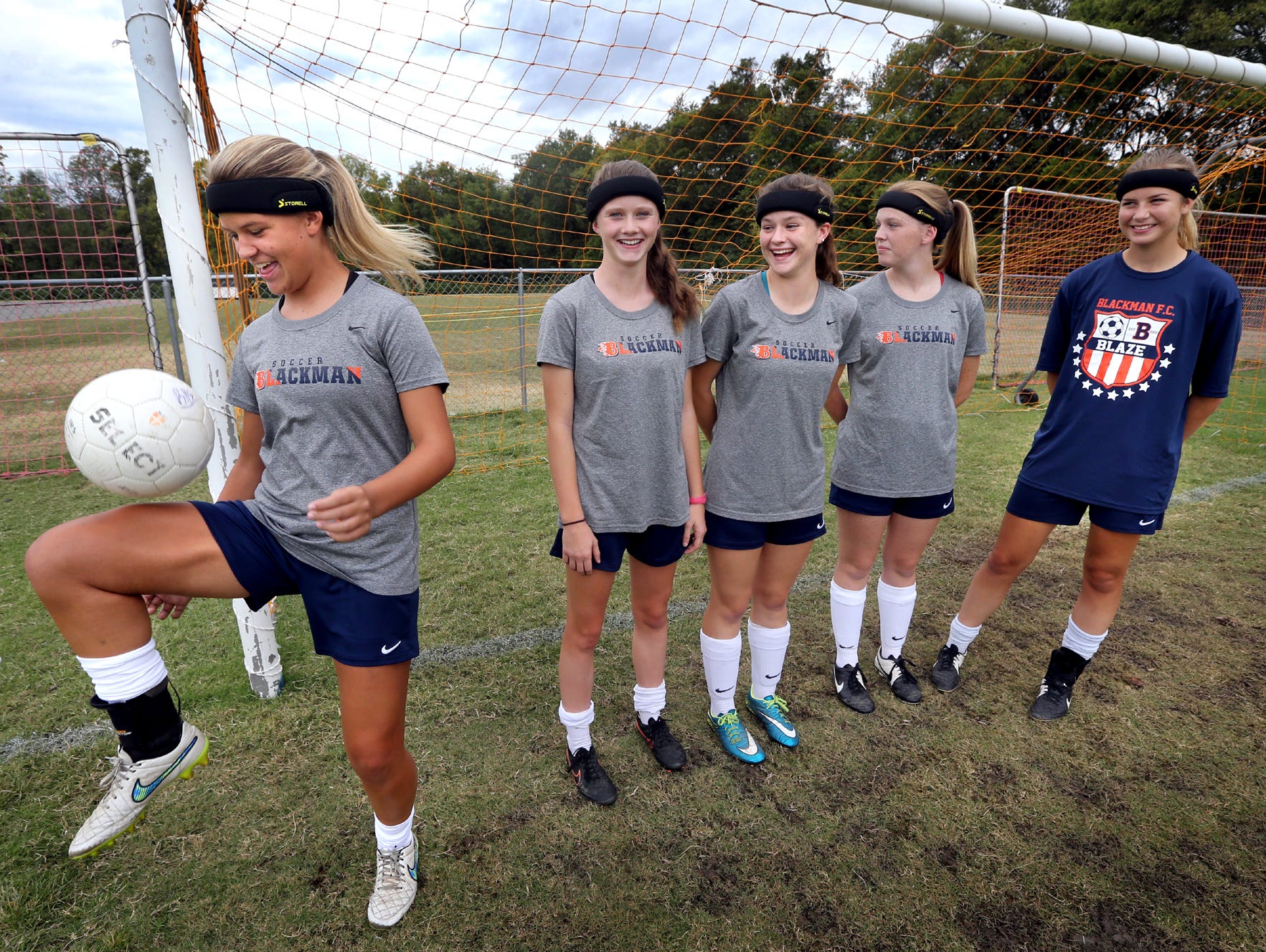
Blackman’s Kenzi Vetter, a sophomore, models the headband that all Blackman girls soccer players must wear before getting on the field for either a game or practice, on Monday, Sept. 28, 2015, before a game against Smyrna. The headbands are suppose to lessen the chances of receiving a concussion.

Smyrna’s Brenda Cernas (13) and Blackman’s Emily Nash (22) both try to head the ball as Blackman’s Amelia Goodnight (31) watches from behind during the first half Monday at Blackman.

Blackman’s Kenzi Vetter heads the ball during a game against Smyrna. The Blackman soccer team wears Storelli head bands to help reduce the risk of concussions.
MURFREESBORO — Bill Vice had to do something.
The 30-year high school soccer coaching veteran, who has been the boys and girls soccer coach at Blackman since it opened in 2000, listened to the staggering injury numbers over the summer during a soccer convention.
A report from the National Federation of High Schools showed that 24.1 percent of the 227,172 girls soccer injuries reported during the 2013-14 school year were concussions. That was the same percentage of concussions from the 149,278 injuries reported in boys soccer during that same year.
“I wanted to protect the girls,” Vice said. “When I saw (those numbers), it just led me to thinking I had to do something.”
That something was mandate wearing Storelli soccer headbands designed to decrease the forces that come with heading a soccer ball or head-to-head contact. That reduction of force is hoped to reduce the risk of head trauma. However, the bands don’t eliminate the risk of concussions.
“I basically said, ‘Don’t step on the soccer field without them,'” Vice said. “Even in practice, if someone says, ‘I don’t have my head gear.’ I’ll tell them, ‘Good, just sit down.’
“It’s tough. I’ve been in this business a long time. This is my 30th year of coaching high school. It just bothered me, the rise of concussions. Maybe I went to the extreme. I don’t know. I’m just trying to protect my players. If I can prevent one, or stop one, it’s worth it.”

Blackman’s Katelyn Davis, a freshman models the headband that all Blackman girls soccer players must wear before getting on the field for either a game or practice, on Monday, Sept. 28, 2015, before a game against Smyrna. The headbands are suppose to lessen the chances of receiving a concussion.
The headbands are black with padding around it for protection. They cost about $65 each. Vice said his booster club helped with purchasing the bands.
TSSAA Executive Director Bernard Childress said mandating headgear for soccer is discussed regularly by the NFHS Soccer Rules Committee.
“They depend on the National Sports Medicine Advisory Committee to make recommendations concerning these issues,” Childress said. “To date the rulebook only states that teams are allowed to wear headgear if they prefer. Data is still inconclusive.”
A protective headband is nothing new to Blackman’s Carly Bowen, who has worn one the past two years due to previous concussions.
“I think it makes us safer,” Bowen said. “It helps. At first we kind of thought it was going to be stupid because we all had them on and no one else did. But I think it’s really helped.
“I think we should start a trend. There is no reason why we shouldn’t. This is safety.”
Central Magnet parent Kevin Miller isn’t sure how much the head bands help. He’s had two daughters Shannon and Kaleigh wear the head band due to concussions. Shannon, a senior, hasn’t worn one for six to eight months. She once did after being concussed as an eighth-grader.
Kaleigh, a sophomore, is wearing a head band.
“It probably wasn’t worthwhile with where they got hit,” Kevin Miller said. “They have never been proven. It’s more psychological. But given the types of impact that they have occurred, it wouldn’t have helped them.
“But something is better than nothing. The majority of (concussions) come from headers where they smash heads. In that case, they are perfectly placed. It’s at least a way of moderating the impact.”
Vice said he is unaware of any other team in the state that wears the headbands. There are players individually who wear the Storeli or similar bands for protection. But he believes those numbers will increase as concussion awareness has become a high priority in recent years.
Florida’s high school association mandated that all girls lacrosse teams wear “soft headgear” beginning this season due to head injuries.
Lora Vetter, whose daughter Kenzi Vetter is a starter for the Lady Blaze, is pleased with Vice’s decision for the team to wear head gear.
“In the beginning I would have not agreed to it, but since they’ve worn them in the games, I’m all for it,” she said. “I think it’s great.
“If it’s an extra precaution, I’m all for it.”
Kenzi Vetter acknowledged she doesn’t love wearing the headbands, but is fine with it if it keeps her on the soccer field.
“If it can keep me from being injured, I’m fine with it,” Kenzie Vetter said. “No one likes being out of soccer for a long time. If it can help prevent concussions then I’m OK with it.
“We still have had (junior varsity) girls that have gotten concussions from being hit in the jaw. You can’t prevent that. But I think it helps give you a better chance of not getting one.”
Reach Tom Kreager at 615-278-5168 and on Twitter @Kreager.

Blackman’s Kenzi Vetter, a sophomore, left juggles the soccer ball while wearing a headband that all Blackman girls soccer players must wear before getting on the field for either a game or practice, on Monday, Sept. 28, 2015, before a game against Smyrna. The headbands are suppose to lessen the chances of receiving a concussion. Vetter’s teammates (L to R) Katelyn Davis, a freshman, Emily Nash, a junior, Mallory Conlin, a sophomore, and Amelia Goodnight, a junior stand behind Vetter as she juggles the ball and are all wearing the same headband.